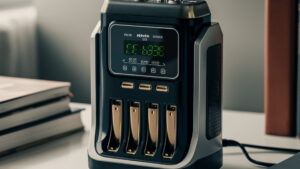Ice fishing is a popular winter activity. Two main tools help anglers: cameras and flashers.
Choosing between an ice fishing camera and a flasher can be tough. Both tools offer unique benefits and can enhance your fishing experience. Cameras let you see underwater action. Flashers show fish location and depth with real-time data. Knowing the difference helps you pick the right gear.
This comparison will guide you through the pros and cons of each. By the end, you will know which tool suits your needs best. Let’s dive in and explore these two options.
Introduction To Ice Fishing Tools
Ice fishing has evolved significantly over the years. Traditional methods relied on patience and luck. Modern tools have changed the game. Two popular gadgets today are ice fishing cameras and flashers. Both have their pros and cons. Understanding them can improve your ice fishing experience.
Importance Of Technology
Technology plays a vital role in ice fishing. It helps anglers locate fish faster. This saves time and increases catch rates. Ice fishing cameras provide a real-time underwater view. Flashers, on the other hand, show depth and fish activity. These tools make ice fishing more efficient and enjoyable.
Brief History Of Fishing Aids
Fishing aids have come a long way. Early anglers used simple tools. Ice fishing began with basic hooks and lines. In the mid-20th century, flashers were introduced. They revolutionized ice fishing by showing depth and fish movement. Later, underwater cameras were developed. These cameras offered a visual advantage. Anglers could see fish and structure beneath the ice. Today, both tools are essential for many ice fishers.
What Is An Ice Fishing Camera?
An ice fishing camera is a device used to see underwater. It helps anglers view fish and underwater structures. With a camera, you can observe fish behavior. This tool makes ice fishing more interactive and fun. It gives a clear view of what lies beneath the ice.
Basic Functionality
The basic functionality of an ice fishing camera is to capture underwater images. The camera is lowered through a hole in the ice. It then sends live footage to a monitor. This allows the angler to see fish and their movements in real-time. The camera often has lights to improve visibility in dark waters.
Key Features
Ice fishing cameras have many key features. They often come with high-resolution monitors. This gives a clear and sharp image. Some cameras have adjustable lights. This helps see in different water conditions. Many cameras also have long cables. This allows you to explore a larger area under the ice.
Durability is another important feature. These cameras are built to withstand freezing temperatures. They often come in waterproof and rugged cases. Some models offer recording functions. This lets you capture and review your fishing adventures.
What Is An Ice Fishing Flasher?
An ice fishing flasher is a device that shows fish location and depth. It helps anglers detect fish under the ice. Comparing it to an ice fishing camera offers different benefits.
Ice fishing flashers are essential tools for ice anglers. These devices help detect fish below the ice. They use sonar technology to display underwater activity in real-time.
Flashers are different from regular fish finders. They are designed specifically for ice fishing. The display shows a circular graph. This graph represents the water column beneath the ice hole.
Flashers are popular among ice fishing enthusiasts. They help locate fish quickly. They also provide information about the depth and structure of the lake. This makes it easier to find the best fishing spots.
Basic Functionality
Ice fishing flashers use sonar to detect fish. They emit sound waves into the water. These waves bounce off objects and return to the device. The flasher interprets these waves and shows them on the display.
The display is usually a circular dial. Different colors represent different objects. For example, red may indicate fish, while green shows the lake bottom. This helps anglers identify fish and other structures easily.
Flashers show real-time data. This means you see what is happening under the ice instantly. You can watch fish move and react to your bait. This helps you adjust your technique and improve your chances of catching fish.
Key Features
Flashers have several key features. These features make them valuable tools for ice fishing.
One important feature is the display. The circular graph shows real-time data. This helps anglers see what is happening below the ice.
Another key feature is the sensitivity adjustment. This allows users to fine-tune the device. You can filter out unwanted signals and focus on detecting fish.
Most flashers also have a zoom function. This helps you focus on a specific depth range. It is useful for targeting fish that are close to the bottom.
Battery life is another important factor. Many flashers come with long-lasting batteries. This ensures you can fish all day without running out of power.
Durability is also crucial. Flashers are designed to withstand cold temperatures. They are built to be rugged and reliable in harsh conditions.
“`
Performance In Various Conditions
Ice fishing can be challenging due to varying water conditions. The performance of an ice fishing camera versus a flasher can differ in clear water and murky water. Understanding these differences can help you decide which device suits your needs better.
Clear Water
In clear water, both an ice fishing camera and a flasher have their advantages. An ice fishing camera provides a direct visual of what’s beneath the surface. You can see fish movements and their reactions to bait. This visual feedback is invaluable for targeting specific species.
A flasher, on the other hand, excels in showing the depth and presence of fish through sonar technology. It indicates the movement of fish and your lure, which is crucial for gauging fish activity. The real-time feedback helps in adjusting your fishing strategy effectively.
| Device | Advantages in Clear Water |
|---|---|
| Ice Fishing Camera | Visual feedback, species identification |
| Flasher | Depth information, real-time feedback |
Murky Water
Murky water presents a different set of challenges. Visibility is limited, impacting the performance of an ice fishing camera. In such conditions, the camera’s effectiveness drops as it relies heavily on clear visuals. The murky water can obscure the camera’s view, making it harder to spot fish.
A flasher, relying on sonar, is less affected by water clarity. It can still provide accurate depth readings and detect fish presence. This makes a flasher more reliable in murky water. The sonar pulses easily penetrate the murky water, giving you a clear picture of what’s below.
| Device | Advantages in Murky Water |
|---|---|
| Ice Fishing Camera | Limited effectiveness due to low visibility |
| Flasher | Reliable sonar readings, unaffected by clarity |
Both devices have their strengths and weaknesses in different water conditions. Choosing the right one depends on the clarity of the water you fish in most often.
Ease Of Use
When choosing between an ice fishing camera and a flasher, ease of use is a key factor. Both devices have their strengths, but how easy are they to set up and use? Let’s dive into the details to help you make an informed decision.
Setup Process
The setup process for an ice fishing camera is straightforward. You simply need to attach the camera to the cable, lower it into the water, and connect it to the monitor. Most cameras come with a user-friendly guide, making the process smooth.
On the other hand, setting up a flasher involves assembling the transducer and positioning it correctly. You need to ensure the transducer is at the right depth for accurate readings. While not difficult, it requires a bit more attention to detail.
User Experience
An ice fishing camera offers a visual experience. You see the fish and the underwater environment in real-time. This makes it easy to understand what’s happening below the ice.
A flasher, while also effective, requires some learning. It uses colors and numbers to show fish activity and depth. Once you get the hang of it, flashers can be very informative. But, there is a learning curve.
For beginners, an ice fishing camera might be more intuitive. The visual feedback helps in understanding fish behavior quickly. Experienced anglers might prefer the detailed data a flasher provides.
Battery Life And Durability
Battery life and durability are crucial for ice fishing equipment. Cameras often provide longer usage with rechargeable batteries. Flashers, however, offer robust durability, ideal for harsh conditions.
Ice fishing enthusiasts often debate the merits of using an ice fishing camera versus a flasher. One critical factor to consider is battery life and durability. Each device has different strengths in these areas.
Typical Battery Duration
Battery life is crucial during long ice fishing trips. Ice fishing cameras usually offer 6-8 hours of battery life. This duration varies by model and usage. Flashers generally have longer battery life, often exceeding 12 hours. This extended life ensures that the device lasts throughout your fishing day.
Weather Resistance
Weather resistance is another important factor. Ice fishing involves harsh conditions. Most ice fishing cameras are designed to withstand cold temperatures. They often come with waterproof features. Flashers are also built tough. Many models resist extreme cold and moisture. This durability ensures longevity and reliability in rough weather.
Both devices have their pros and cons. Understanding battery life and durability helps in making an informed choice. Choose the one that best suits your fishing needs.
“`
Cost Comparison
Choosing between an ice fishing camera and a flasher involves considering the costs. Understanding the initial investment and maintenance costs can help you make an informed decision. Below, we break down these cost factors for both devices.
Initial Investment
The initial cost of an ice fishing camera varies based on features. Basic models start around $100. High-end models can cost up to $500 or more.
Flashers, on the other hand, generally have a lower starting price. Entry-level flashers can be found for about $150. More advanced models may go up to $400.
| Device | Price Range |
|---|---|
| Ice Fishing Camera | $100 – $500+ |
| Flasher | $150 – $400 |
Maintenance Costs
Maintenance costs for ice fishing cameras can add up. These devices often require battery replacements or upgrades. Additionally, camera lenses might need occasional cleaning or replacement.
Flashers usually have lower maintenance costs. They mainly need battery replacements. Less complex electronics mean fewer parts to maintain.
- Ice Fishing Camera: Battery replacements, lens cleaning/replacement
- Flasher: Battery replacements
Overall, flashers are generally more cost-effective in the long run. Yet, the choice depends on your specific needs and preferences.
Making The Right Choice
Choosing between an ice fishing camera and a flasher can be challenging. Each tool has its own strengths and weaknesses. Your decision will depend on your personal preferences and fishing goals. Let’s explore these factors to help you make the right choice.
Personal Preferences
Your personal preferences play a key role in this decision. Do you prefer visual confirmation of fish? If so, an ice fishing camera might be best. Cameras provide real-time underwater footage. You can see the fish’s behavior and environment.
On the other hand, flashers are more traditional. They use sonar to display fish and depth data. Many anglers find flashers easier to read. They offer a quick snapshot of underwater activity. Consider which type of feedback you prefer.
Fishing Goals
Your fishing goals also influence your choice. Are you looking to catch more fish or simply enjoy the experience? Cameras can make the experience more immersive. You see exactly what’s happening below the ice. This can be educational and fun.
If your goal is to catch more fish, a flasher might be better. Flashers provide immediate information on fish location and movement. This can help you react quickly and adjust your tactics.
Consider how each tool aligns with your fishing objectives. Your goals will guide you to the right choice.

Frequently Asked Questions
What Is An Ice Fishing Camera?
An ice fishing camera is a device that helps anglers see underwater. It provides real-time video footage. This helps in locating fish and understanding their behavior.
How Does A Flasher Work For Ice Fishing?
A flasher uses sonar technology to detect fish under the ice. It displays fish location, depth, and movement. This helps anglers target fish more effectively.
Which Is Better For Beginners, Camera Or Flasher?
For beginners, a flasher is easier to use. It provides quick and accurate fish location information. Cameras require more setup and interpretation skills.
Can You Use Both A Camera And A Flasher?
Yes, using both can be beneficial. A camera provides visual confirmation, while a flasher offers real-time data. This combination improves your chances of catching fish.
Conclusion
Choosing between an ice fishing camera and a flasher depends on your needs. Ice fishing cameras offer real-time visuals, enhancing your underwater experience. Flashers provide accurate depth and fish location, crucial for serious anglers. Both tools have unique benefits and can improve your fishing success.
Consider your fishing style and budget before deciding. Remember, the right tool can make your ice fishing trips more enjoyable. Happy fishing!








